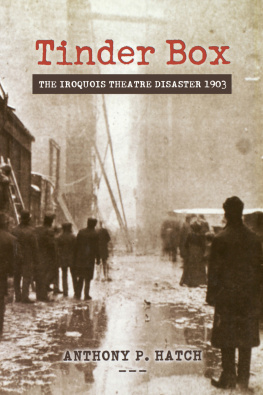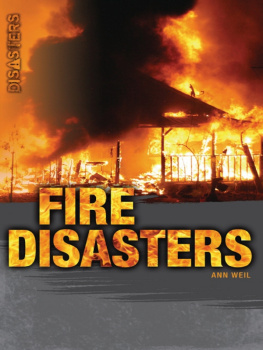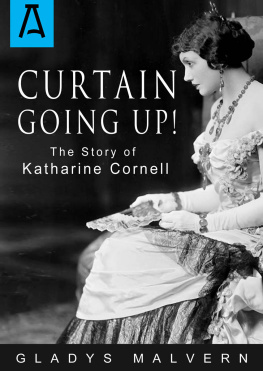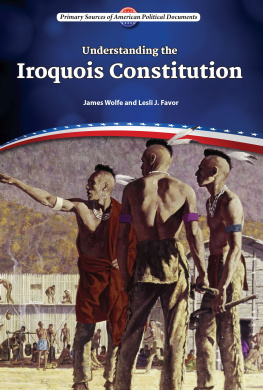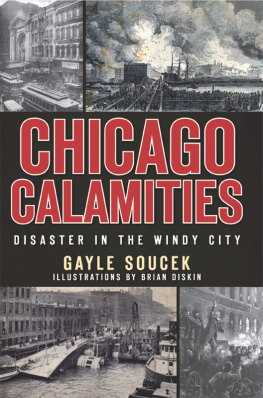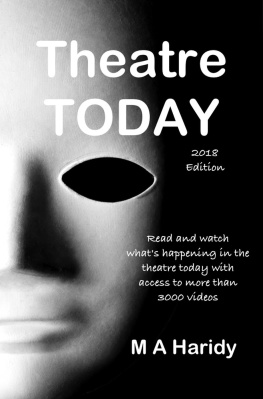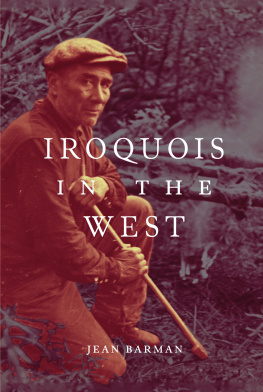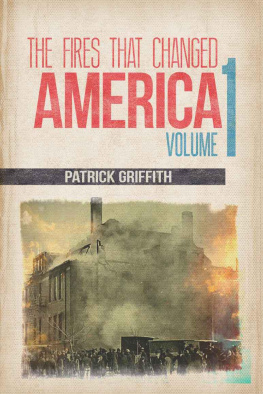

Published in 2003 by
Academy Chicago Publishers
363 West Erie Street
Chicago, Illinois 60610
2003 by Anthony P. Hatch
Printed in the U.S.A.
All rights reserved.
No part of this book may be reproduced in any form without the express written permission of the publisher.
Library of Congress Cataloging-in-Publication Data on file with the publisher
Dedicated to Lenore
To the memory of my parents Archibald Lewis Hatch and Pearl Berkman Hatch
To Gerald Miller and George Syverson, CBS News, Killed in Cambodia, 1970
And to Americas firefighters, police and emergency service personnel, heroes all

We learn from history that we learn nothing from history G EORGE BERNARD SHAW
CONTENTS
I NDEX
FOREWORD
O N F EBRUARY 13, 1875, the Chicago Times stunned its readers by predicting a terrible theatre disaster waiting to happen. In a city that only four years earlier had been devastated by what was called The Great Chicago Fire, the Times, in lurid detail, described a tragedy in an absolutely fireproof theatre filled to overcapacity one winters day with women and children who were watching a musical comedy.
In this fictionalized account, audience members jammed the exits in a mad rush to escape while the shows leading comedian rushed on stage just as the fire safety curtain burst into flames. Hundreds were horribly burned, crushed to death or asphyxiated and the Times warned that safety provisions were generally so lax that the make-believe story could at any time become a reality.
Twenty-eight years later, on one winter day, the nightmare prediction came true in almost every ghastly detail.
Now nearly forgotten, the horror of the Iroquois Theatre remains to this day the worst catastrophe in the history of the American stage.
INTRODUCTION
T HE IDEA FOR THIS BOOK began before the advent of color television, the personal computer, the fax machine or the internet. I developed a childhood interest in the disaster when I read a book called Lest We Forget, a compilation of press stories of the fire, some of them contradictory, published in 1904 as a means of raising money for the victims families.
When I read the late Walter Lords A Night to Remember, in 1955, I was struck by the similarities between the Iroquois tragedy and the Titanic disaster, which Lord so brilliantly documented:
A magnificent ship said to be unsinkable, and an equally magnificent theatre advertised as absolutely fireproof.
A luxurious new vessel on its maiden voyage, and a luxurious new playhouse, open only a matter of weeks, presenting its dedicatory performance.
The incredible human miscalculations. Not enough lifeboats on the ship, and virtually no firefighting equipment in the theatre.
A vessel possessing the new wireless technology that proved useless because the nearest ship did not receive its signals, and a theatre boasting every modern convenience but lacking any means to communicate by telephone or alarm with a fire station one block away.
A ship rushing through a dark sea on orders from its owners who ignored warnings of danger; a theatre opened hastily by its owners who ignored warnings that it was dangerously incomplete.
The hubris and greed displayed by the owners of the ship and the owners of the theatre.
The terrible and inexcusable loss of life of passengers on the Titanic and of the audience in the Iroquois Theatre. Many passengers on the ship locked behind gates, the theatregoers trapped behind locked and bolted gates and doors.
The worldwide disbelief, horror and outrage when the news of each disaster became known and the reforms each catastrophe brought about.
I have drawn heavily from accounts in the 1904 book and have done original research in contemporary newspapers and magazines published in Chicago, New York, London and other cities, and in accounts published later.
My research began in 1961 in Chicago when I interviewed former Fire Commissioner William Corrigan, who had fought the fire and who gave me a detailed description of everything from piles of snow in the street that day to the rescue attempts inside the burning theatre.
A few months later, while on assignment for CBS News, I had an opportunity to make repeated visits to the Chicago Historical Society to examine its materials on the disaster, including its extensive collection of photographs. More importantly, while I was in the city, I was able to record a lengthy interview with Charles Collins, who had covered the story as a young newspaper reporter. In response to public solicitations here and in England, I received letters from many people including an AP reporter who was there, as well as a former Northwestern University student who had helped in the rescues.
Though I had accumulated much research material, a career path that led to the Middle East, then to New York City and eventually to Los Angeles and Santa Fe, prevented me from completing the story until now, three decades later.
All the accounts in this book are based on original newspaper and magazine reports, on interviews and correspondence from the 1960s, and on conversations over the past three years with social historians, theatre specialists, librarians, lawyers, doctors, forensic experts, fire department historians and distant relatives of victims who had knowledge of the disaster. There are no fictionalized characters or quotations in these pages. Despite having spent most of his adult life as a writer, Charles Collins died without apparently leaving any memoir, diary or journal describing highlights of his career. I interviewed him at length in 1962, and after he died two years later I filled in some information on his early years from various sources.
Contemporary newspaper accounts of the tragedy were, in some cases, contradictory or even mistaken, and, owing to the poor quality of microfilm reproduction, often almost impossible to read, even with a magnifying glass. Perhaps the most difficult fact to pin down was the actual number of victims. The official list as tabulated by the coroners office, for instance, is missing the names of some victims mentioned in the Chicago papers. This is probably because of great initial confusion at the scene, and, too, because some victims were removed by families who failed to notify authorities.
News photography of the time was still in its infancy, dependent on bulky cameras, glass plate negatives, magnesium flash powder, which could sometimes injure cameramen, and the need for the subject usually to stand absolutely still, to avoid blurring of the image. This would explain why most of the photographs of the theatres interior after the fire have more definition and detail than those shot in the street at the time of the fire, and would explain also why some Chicago newspapers quickly dispatched courtroom sketch artists to capture visuals that photographers were unable to record.
A search around the country via the internet and through personal phone calls turned up little in the way of publicity shots of the Mr. Bluebeard production as it appeared on stage, either in New York or Chicago. That seems to me to be remarkable, given the fact that extensive production shots were taken of other shows that same year. The photo of the Pale Moonlight double octet is reprinted here, along with others like the Pony Ballet chorus, from sheet music published at the time. My thanks to Scott Stephen of Santa Fe for his deft digital engineering to restore many of the visuals to their original state or even to enhance them.
Next page
